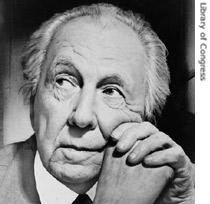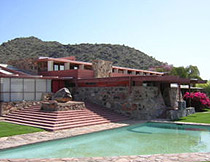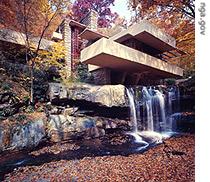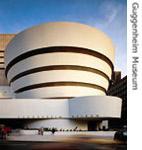VOA慢速英语 2007 0429
时间:2018-12-07 作者:英语课 分类:VOA慢速英语2007年(四)月
VOICE ONE:
I’m Phoebe Zimmerman.
VOICE TWO:
And I’m Steve Ember with the VOA Special English program People in America. Today we tell about the life and work of the greatest American building designer of the twentieth century, Frank Lloyd Wright.
(MUSIC)
VOICE ONE:
Frank Lloyd Wright designed buildings for more than seventy years. He did most of his

Frank Lloyd Wright
work from nineteen hundred through the nineteen fifties. He designed houses, schools, churches, public buildings, and office buildings.
Critics say Frank Lloyd Wright was one of America's most creative architects. One critic said his ideas were fifty years ahead of the time in which he lived.
(MUSIC)
VOICE TWO:
Frank Lloyd Wright was born in eighteen sixty‑seven in the middle western state of Wisconsin. He studied engineering at the University of Wisconsin. In eighteen eighty‑seven, he went to the city of Chicago. He got a job in the office of the famous architects, Louis Sullivan and Dankmar Adler.
Several years later, Wright established his own building design business. He began by designing homes for people living in and near Chicago. These homes were called "prairie houses."
VOICE ONE:
Prairie houses were long and low. They seemed to grow out of the ground. They were built of wood and other natural materials. The indoors expanded to the outdoors by extending the floor. This created what seemed like a room without walls or a roof.
In nineteen-oh-two, Wright designed one prairie house, called the Willits House, in the town of Highland 1 Park. The house was shaped like a cross. It was built around a huge fireplace 2. The rooms were designed so they seemed to flow into each other.
VOICE TWO:

Robie House
Visitors to Chicago can see another of Wright's prairie houses. It is called the Robie House. It looks like a series of long, low rooms on different levels. The rooms seem to float over the ground. Wright designed everything in the house, including the furniture and floor coverings.
Wright's prairie houses had a great influence on home design in America. Even today, one hundred years later, his prairie houses appear very modern.
VOICE ONE:
In the nineteen thirties, Wright developed what he called "Usonian" houses. Usonia was his name for a perfect, democratic United States of America. Usonian houses were planned to be low cost. Wright designed them for the American middle class. These are the majority of Americans who are neither very rich nor very poor.
Frank Lloyd Wright believed that all middle class families in America should be able to own a house that was designed well. He believed that the United States could not be a true democracy if people did not own their own house on their own piece of land.
VOICE TWO:
Usonian houses were built on a flat base of concrete. The base was level with the ground. Wright believed that was better and less costly 3 than the common method of digging a hole in the ground for the base. Low‑cost houses based on the Usonian idea became very popular in America in the nineteen fifties. Visitors can see one of Wright's Usonian homes near Washington, D. C. It is the Pope-Leighy House in Alexandria, Virginia.
(MUSIC)
VOICE ONE:
Frank Lloyd Wright believed in spreading his ideas to young building designers. In nineteen thirty‑two, he established a school called the Taliesin Fellowship 4. Architectural students paid to live and work with him.
During the summer, they worked at his home near Spring Green, Wisconsin. Wright called this house "Taliesin." That is a Welsh name meaning "shining brow." It was built of stone and wood into the top of a hill.
During the winter, they worked at Taliesin West. This was Wright’s home and architecture office near Phoenix 5, Arizona. Wright and his students started building it in nineteen thirty-seven in the Sonoran Desert.
VOICE TWO:
Taliesin West is an example of Frank Lloyd Wright’s ideas of organic architecture taking

Taliesin West
root in the desert. He believed that architecture should have life and spirit. He said a building should appear to grow naturally and easily from its base into its surroundings. Selecting the best place to put a building became a most important first step in the design process.
Frank Lloyd Wright had discovered the beauty of the desert in nineteen twenty-seven when he was asked to help with the design of the Arizona Biltmore hotel. He continued to return to the desert with his students to escape the harsh 6 winters in Wisconsin.
Ten years later he found a perfect place for his winter home and school. He bought about three hundred hectares of desert land at the foot of the McDowell Mountains near Scottsdale, Arizona.
Wright said: ‿I was struck by the beauty of the desert, by the dry, clear sun-filled air, by the stark 7 geometry of the mountains.‿nbsp; He wanted everyone who visited Taliesin West to feel this same sense of place.
VOICE ONE:
His architecture students helped him gather rocks and sand from the desert floor to use as building materials. They began a series of buildings that became home, office and school. Wright kept working on and changing what he called a building made of many buildings for twenty years.
Today, Taliesin West has many low stone buildings linked together by walkways and courtyards. It is still very much alive with activity. About seventy people live, work and study there. Guides take visitors through what is one of America’s most important cultural treasures.
VOICE TWO:

Falling Water
In nineteen thirty‑seven, Wright designed a house near the city of Pittsburgh, Pennsylvania. It is a fine example of his idea of organic architecture. The house is called "Fallingwater." It sits on huge rocks next to a small river. It extends over a waterfall. From one part of the house, a person can step down a stairway over the water.
"Fallingwater" is so unusual and so beautiful that it came to represent modern American architecture. One critic calls it the greatest house of the twentieth century. Like Taliesin West, "Fallingwater" is open to the public.
VOICE ONE:
Frank Lloyd Wright also is famous for designing imaginative 8 public buildings. In nineteen‑oh‑four, he designed an office building for the Larkin Soap Company in Buffalo 9, New York. The offices were organized around a tall open space. At the top was a glass roof to let sunlight into the center.
In the late nineteen thirties, Wright designed an office building for the Johnson Wax Company in Racine, Wisconsin. It also had one great room without traditional walls or windows. The outside of the building was made of smooth, curved brick and glass.
(MUSIC)
VOICE TWO:
In nineteen forty‑three, Frank Lloyd Wright designed one of his most famous projects: the Guggenheim Museum of Art in New York City. The building was completed in nineteen sixty, the year following his death.
The Guggenheim is unusual because it is a circle. Inside the museum, a walkway rises

The Guggenheim Museum in New York
in a circle from the lowest floor almost to the top. Visitors move along this walkway to see the artwork on the walls.
The Guggenheim museum was very different from Wright's other designs. It even violated 10 one of his own rules of design: the Guggenheim's shape is completely different from any of the buildings around it.
VOICE ONE:
When Wright was a very old man, he designed the Marin County Civic 11 Center in San Rafael, California, near San Francisco. The Civic Center project was one of his most imaginative designs. It is a series of long buildings between two hills.
Frank Lloyd Wright believed that architecture is life itself taking form. “Therefore,‿he said, “it is the truest record of life as it was lived in the world yesterday, as it is lived today, or ever will be lived.‿
Frank Lloyd Wright died in nineteen fifty-nine, in Phoenix, Arizona. He was ninety‑one years old. His buildings remain a record of the best of American Twentieth Century culture.
(MUSIC)
VOICE TWO:
This Special English program was written by Shelley Gollust and Marilyn Christiano. It was produced by Lawan Davis. Our studio engineer was Max Carroll. I’m Steve Ember.
VOICE ONE:
And I’m Phoebe Zimmerman. Join us again next week for another People in America program on the Voice of America.
- The highland game is part of Scotland's cultural heritage.苏格兰高地游戏是苏格兰文化遗产的一部分。
- The highland forests where few hunters venture have long been the bear's sanctuary.这片只有少数猎人涉险的高山森林,一直都是黑熊的避难所。
- The fireplace smokes badly.这壁炉冒烟太多。
- I think we should wall up the fireplace.我想应该封住壁炉。
- It must be very costly to keep up a house like this.维修这么一幢房子一定很昂贵。
- This dictionary is very useful,only it is a bit costly.这本词典很有用,左不过贵了些。
- You'll lose your fellowship if you do that.你如果做那件事就会丧失研究员职位。
- It looks that they'll be admitted to the fellowship.看来他们要被吸收入会了。
- The airline rose like a phoenix from the ashes.这家航空公司又起死回生了。
- The phoenix worship of China is fetish worship not totem adoration.中国凤崇拜是灵物崇拜而非图腾崇拜。
- The sunlight is very harsh.太阳光很刺眼。
- Although his words are harsh,there is positiveness in them.虽然他的话很苛刻,但有建设性。
- The young man is faced with a stark choice.这位年轻人面临严峻的抉择。
- He gave a stark denial to the rumor.他对谣言加以完全的否认。
- The imaginative child made up fairy stories.这个想像力丰富的孩子自己编神话故事。
- Scott was an imaginative writer.司格特是位富于想象力的作家。
- Asian buffalo isn't as wild as that of America's. 亚洲水牛比美洲水牛温顺些。
- The boots are made of buffalo hide. 这双靴子是由水牛皮制成的。